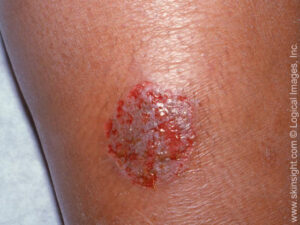What is nummular eczema and what should you do if you have it? (original) (raw)
What is nummular eczema?
Nummular eczema, also known as discoid eczema and nummular dermatitis, features scattered circular, often itchy and sometimes oozing patches. The word “nummular” comes from the Latin word for “coin,” as the spots can look coin-shaped on the skin.
Who gets nummular eczema and why?
Nummular eczema can occur at any age, and males tend to develop it more often than females.
Its causes aren’t clear, but triggers can include very dry or sensitive skin and trauma to the skin from insect bites, scrapes or chemical burns.
Nummular eczema may also develop as a reaction to some other types of eczema and their triggers, such as contact dermatitis and nickel. When it appears on the legs, it can be linked to poor blood flow in the lower body and the stasis dermatitis those circulation problems can cause.
What are the symptoms of nummular eczema?
Symptoms of nummular eczema can include:
- coin-shaped lesions on arms, legs, torso and/or hands
- itching and burning
- lesions that are oozing liquid or have crusted over
- red, pinkish or brown, scaly and inflamed skin around the lesions
How is nummular eczema treated?
Nummular eczema can look like psoriasis, ringworm, fungal infection and other types of eczema, including atopic dermatitis, stasis dermatitis and contact dermatitis. It can also occur along with those types of eczema, though it often appears as an isolated condition. Dermatologists can usually spot the condition but may take a skin scraping to confirm a diagnosis.
Once correctly diagnosed, nummular eczema tends to disappear completely with the right treatment. However, unlike some other forms of eczema, nummular seldom improves without relatively aggressive treatment.
Like atopic dermatitis, patches of nummular eczema are often infected with Staphylococcus aureus (staph), which needs to be treated along with the skin inflammation to clear the condition.
Nummular eczema can be treated with a mid- or high-potency topical corticosteroid, along with a topical antibiotic. If eczema patches are substantially weepy and oozy, application of an astringent compress can help dry the area and drive out any staph infection.
What do the ecz-perts have to say?
“Once we identify nummular eczema and treat it appropriately, most people are significantly better within seven to 10 days, and, for patients who don’t have another type of eczema, it often never comes back,” according to Dr. Peter Lio, founding director of the Chicago Integrative Eczema Center. “Even in those for whom this is a manifestation of their underlying atopic dermatitis, the nummular aspect seems to disappear quickly and then we can go back to overall management.”
